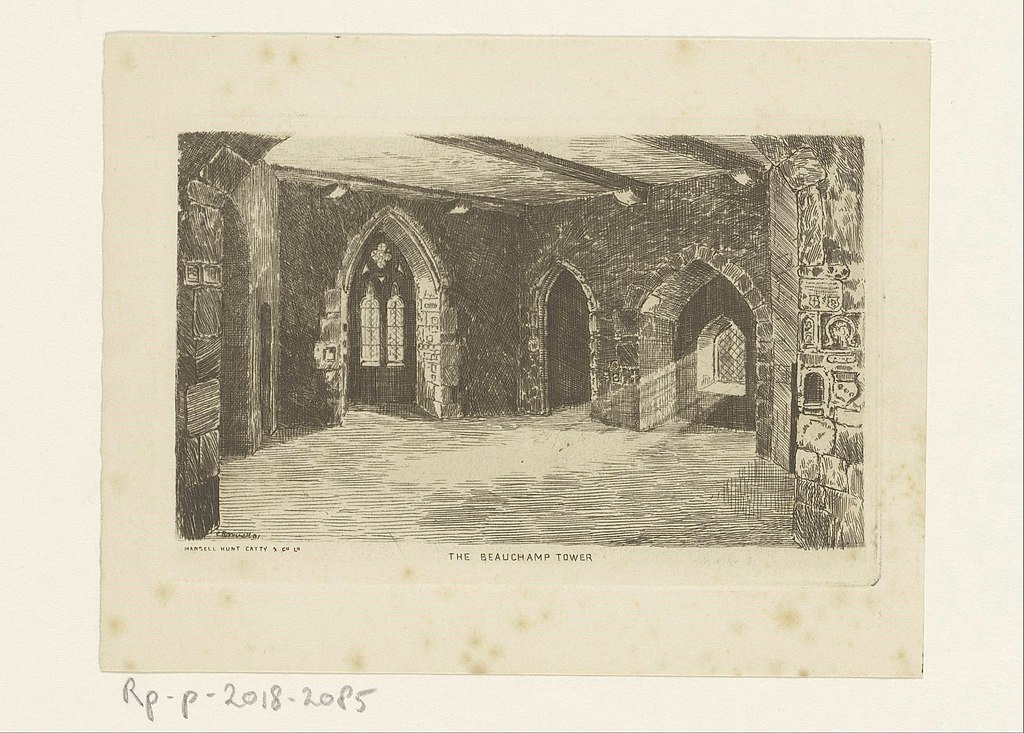


Public Domain 
By Dirk Ingo Franke https://commons.wikimedia.org/wiki/File:London_beauchamp_tower_08.03.2013_12-32-44.JPG
- Tower of London, London | 51.5083° N, 0.0773° W
- Acquired by General Reeve in March of 1887
- BM# 1948.64.094
This piece of metal, showing signs of wearing through time, was taken from the Beauchamp Tower in the Tower of London. The cannister it was housed in identifies it as a nail. The metal it was made of has signs of patina, a layer of film over a metal that indicates its exposure to the elements over time. The Beauchamp Tower is famous for its graffiti, as it was used to house prisoners in the sixteenth and seventeenth centuries.
There is no information regarding the acquisition of the object. Reeve has not left any anecdotes of his visit to the Tower of London or of the nail fragment itself.
The Beauchamp Tower in the Tower of London was built in AD 1281, under the reign of Edward I (1239-1307). This tower was meant to be a part of the Tower of London’s inner defensive wall. Edwards I reign was characterized by constant warfare, explaining his need for extra fortification of the Tower of London (Lagasse, P. & Columbia University, 2018). The name we call the tower today did not arrive, however, for another century. The tower was named after Thomas Beauchamp, the Earl of Warwick, who was a prisoner in the Tower towards the end of the 14th century. Beauchamp was imprisoned due to his rebellion against Richard II (1367-1400), who was in power by this time. Richard II was an unpopular king both with his people and with the parliament. This tense relationship caused many impeachments, executions, imprisonments, one of them being Thomas Beauchamp. (BBC, n.d.) The Beauchamp Tower was of much use to both of these kings that reigned during unstable times.
Most prisoners in the Beauchamp Tower were of elite social status. These prisoners spent long amounts of time in the tower and many of them had been sentenced to death. This caused many prisoners to find ways to immortalize themselves and carve graffiti into the walls of the Tower. Among these prisoners were Robert Dudley (Earl of Leicester), Thomas Abel (Chaplain to Katherine of Aragon), and Philip Howard (Earl of Arundel). (Historic Royal Palaces, n.d.)
For Further Reading
- Allen Brown, R. and Curnow, P 1984, Tower of London, Greater London: Department of the Environment Official Handbook, Her Majesty’s Stationery Office.
- BBC. n.d. Richard II (1367-1400). Accessed April 6, 2020. http://www.bbc.co.uk/history/historic_figures/richard_ii_king.shtml
- Dick, W.R. 1891. A Short Sketch of the Beauchamp Tower, Tower of London: And Also a Guide to the Inscriptions and Devices Left on the Walls Thereof. Bemrose.
- Historic Royal Palaces. n.d. “Imprisonment at the Tower of London exhibition: Within the Beauchamp Tower.” Tower of London. Accessed April 6, 2020. https://www.hrp.org.uk/tower-of-london/whats-on/imprisonment-at-the-tower-exhibition/#gs.3xcsit
- Lagasse, P. and Columbia University. 2018. “Edward I.” In The Columbia Encyclopedia. 8th ed. Columbia University Press.
- Thornbury, W. 1878. “The Tower” In Old and New London. 60-76. London: Cassell, Petter & Galpin.
- U.N.E.S.C.O. n.d. “Tower of London” Accessed April 6, 2020. https://whc.unesco.org/en/list/488/